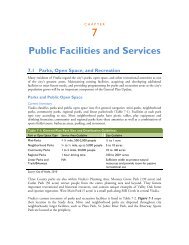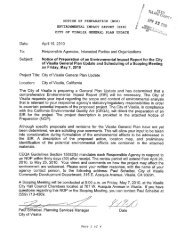General Plan Update Review Committee Draft Elements Part 2 For ...
General Plan Update Review Committee Draft Elements Part 2 For ...
General Plan Update Review Committee Draft Elements Part 2 For ...
You also want an ePaper? Increase the reach of your titles
YUMPU automatically turns print PDFs into web optimized ePapers that Google loves.
4 CIRCULATION<br />
The Circulation Element of the 2030 <strong>General</strong> <strong>Plan</strong> is<br />
intended to provide guidance and specific actions to<br />
ensure the continued safe and efficient operation of<br />
Visalia’s circulation system. The Element is based on<br />
a fundamental philosophy that traffic conditions in<br />
the City can be managed through a comprehensive<br />
program of transportation planning, land use planning,<br />
and growth management strategies. This Element<br />
includes provisions for roadways, transit, aviation,<br />
pedestrian, and bicycle transportation modes, as<br />
well as parking conditions.<br />
The Circulation Element responds directly to the<br />
Government Code [Section 65302(b)], which requires<br />
“a circulation element consisting of the general location<br />
and extent of existing and proposed major thoroughfares,<br />
transportation routes, terminals, any military<br />
airports and ports, and other local public utilities<br />
and facilities, all correlated with the land use element<br />
of the plan.”<br />
State Law recognizes that circulation and land use are<br />
closely related and requires that policies in this Element<br />
and the Land Use Element be linked. Careful<br />
integration of the City’s traffic and circulation policies<br />
with its land use policies will ensure that there<br />
is sufficient roadway capacity to accommodate traffic<br />
generated by planned future development. The City<br />
is committed to designing a system of regional routes,<br />
local roads, public transit and bicycle and pedestrian<br />
pathways that will enhance the community and protect<br />
the environment.<br />
The Land Use Element contains policies related to<br />
the physical framework for development that the circulation<br />
system is designed to serve all transportation<br />
users including vehicles, trucks, bicyclists and pedestrians.<br />
This Element also addresses landscaping along<br />
major streets and planning for street connectivity in<br />
new neighborhoods. It discusses how to create pedestrian-friendly<br />
environments and design for alternate<br />
modes of transportation. The Noise Element of the<br />
<strong>General</strong> <strong>Plan</strong> includes policies to alleviate noise generated<br />
by traffic conditions.<br />
4.1 COMPLETE STREETS FRAMEWORK<br />
In September 2008, the Governor signed into law the<br />
California Complete Streets Act, requiring <strong>General</strong><br />
<strong>Plan</strong>s to develop a plan for a multi-modal transportation<br />
system. The goal of the Act is to encourage cities<br />
to rethink policies that emphasize automobile circulation<br />
and prioritize motor vehicle improvements,<br />
and come up with creative solutions that emphasize<br />
all modes of transportation. Complete Streets design<br />
has many advantages. When people have more transportation<br />
options, there are fewer traffic jams and<br />
the overall capacity of the transportation network<br />
increases. Complete Street design attends to the<br />
needs of people who don’t travel by automobile, who<br />
have often been overlooked. Additionally, increased<br />
transit ridership, walking, and biking can reduce air<br />
pollution, energy consumption, and greenhouse gas<br />
emissions, while improving the overall travel experience<br />
for road users.<br />
DRAFT ELEMENTS<br />
<strong>For</strong> <strong>General</strong> <strong>Plan</strong> <strong>Update</strong> <strong>Review</strong> <strong>Committee</strong><br />
The City is committed to designing a system of<br />
regional routes, local roads, public transit and bicycle<br />
and pedestrian pathways that will enhance the<br />
community and protect the environment.<br />
AUGUST 2012<br />
4-1




